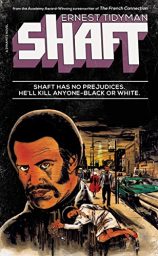
With all the films, remakes, comics, and an earworm of a musical theme, the franchise leads to larger-than-life expectations for Ernest Tidyman’s 1971 novel Shaft, the novel which started it all. If not a superhero, then certainly an icon. Instead, John Shaft is presented as a street-weary Army vet, a detective working for unsavory characters in desperate settings. A man, rather than an identity, full of anger, daring, and hard-earned caution instead of style and stereotype. This was a deliberate choice by Tidyman, who noticed
“Reading black fiction, you see that the central figure is either super hero or super victim, as in [William] Styron’s book. The blacks I knew were smart and sophisticated, and I thought, what about a black hero who thinks of himself as a human being, but who uses his black rage as one of his resources, along with intelligence and courage.”
The result is a languid noir thriller, with the two main characters of Shaft and the tinderbox that was 1970s New York taking center stage.
Shaft’s case, to find a kidnapped daughter of a Harlem crime lord, puts him in the center of a riotous mess of Mafia, Black Power revolutionaries, Jewish merchants, and corrupt cops. In today’s Michael Bay-driven landscape, rescuing the girl from a Mafia safe house during an astroturfed race riot would be a set piece occupying most of the book. Instead, that action is allowed to play in the break between chapters. The novel’s tension–and Shaft’s skills–are built instead around locating her in the first place. And it’s Shaft’s observations that lift this hard-boiled crime tale from being just one more in an interchangeable string of genre books, whether simple observations such as “He was being honest, honest as a man with three walnut shells. And a round bean.” or revealing inconvenient truths:
“He remembered men who knew and made it work. They paid their dues. This one didn’t know except how to look on that box on the wall. Too many of them only knew that, nothing more. Too many of the young ones knew how to look, how to talk. But they didn’t know how anything worked.”
But such wit and wisdom is not reserved for Shaft alone. Whether a Black Power revolutionary blasting a black crime lord for his monopoly on black suffering, or the same revolutionary getting dressed down for how amateur his operation is, everyone has a bit of truth to them, and everyone is in need of hearing it from others. The result anchors Shaft in reality more firmly than merely copying the street fashions and slang of the time.
Unfortunately, Shaft is nearly 50 years old, and five decades of homage, imitation, and inspiration have dulled today’s readers to what made Shaft novel for its time. Without that, the novel is merely one of many good street detective tales, remarkable only for its milieu. But at a time where identitarian tensions are growing, and the only acceptable fiction roles for people are superhero, supervictim, and supervillain, perhaps it is time to revisit 1970s New York and a street detective named Shaft.
Please give us your valuable comment